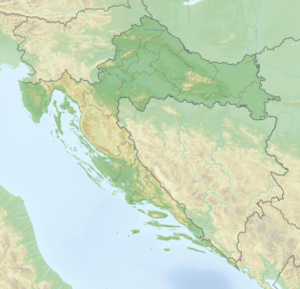Ostrovica fortress
| Ostrovica fortress | ||
|---|---|---|
|
Steep rock with the remains of the former fortress |
||
| Alternative name (s): | Ostrovica Castle | |
| Creation time : | 12th Century (?) | |
| Castle type : | Summit Castle ( Felsenburg ) | |
| Conservation status: | ruin | |
| Standing position : | Nobles | |
| Construction: | Ashlar | |
| Place: | Ostrovica (Lišane Ostrovičke) , Croatia | |
| Geographical location | 43 ° 57 '36 " N , 15 ° 47' 24" E | |
|
|
||
The ostrovica fortress [ Ostrowitza ] is in the south Croatian location Ostrovica preferred Burgruine . It is located on a hill in the outskirts between the historical regions of Ravni kotari and Bukovica . Once one of the most important fortresses in Croatia, known as the key to the city of Zadar , it was practically razed to the ground during the Venetian - Ottoman Wars in the second half of the 17th century, so only a few remains of ruins have survived to this day.
historical overview
The first mention of the fortress, according to the well-known Croatian historian Vjekoslav Klaić , came in the second half of the 12th century, when the Byzantine historian Johannes Kinnamos listed the Croatian places conquered by the emperor Manuel I Komnenos , including Split , Trogir , Šibenik , Skradin and Ostrovica. The second mention dates from the end of the 12th century, when the then duke and later Croatian-Hungarian king Andreas II of Arpad camped with his troops near castrum Ostrovica after a campaign in 1198 .
Until 1347, the fortress and the entire Bribir County were owned by the noble dynasty Šubić . After the death of Pavao (Paul) II. Šubić von Bribir in 1346, his underage son Juraj (Georg) III. and his uncle and guardian Grgur (Gregor) V. - Paul's younger brother - the fortress. Soon, however, King Ludwig von Anjou asked to take over the strategically important Ostrovica in order to wage the war against the Venetians more successfully. In exchange he gave the Juraj III. the distant rule of Zrin in what was then Slavonia and confirmed this in a document dated July 31, 1347.
A little later, King Ludwig succeeded in liberating all of Dalmatia from the Venetians, which was confirmed with the Zadar Peace Treaty in 1358. Ostrovica remained an important military base of the king all along. Since ancient times it has enabled comprehensive control over the traffic routes that cross there, namely the Siscia - Salona connection connecting the north with the south and the Knin - Zadar route ( Latin Iadera / Jadera /), where they defended the eastern access to Zadar, the most important city in the region in the 14th century. After Ludwig's death, the owners of the fortress often changed, so that it even came into the hands of the powerful Bosnian King Stjepan Tvrtko I. Kotromanić between 1388 and 1391 . During the 15th century it was owned for some time by the returning Venetians, who in the meantime (1409) bought all of Dalmatia from King Ladislaus of Naples for 100,000 ducats.
After Bosnia fell into Turkish hands in 1463, the fortress was increasingly threatened by the expansionism of the Ottoman Empire , but remained part of Croatian territory until 1523 . Only after bitter fighting did the Turks succeed in conquering them. In the next few decades it was almost always on the outskirts between the Ottoman and Venetian borders in what was then Croatia and changed hands several times.
So fought over, the fortress was destroyed in the second half of the 17th century. It is known that it still existed in 1671 when Stojan Janković was its Venetian military commander. He was famous as an implacable opponent of the Ottomans. A little later, the fortress was razed to the ground, so that only a few remains have been preserved on the flat plateau above the steep rock of Ostrovica, including parts of the stone cistern , a stone staircase and fragments of Gothic glaze ceramic .




